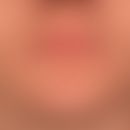Synonym(s)
HistoryThis section has been translated automatically.
As lichen planus obtusus by PG Unna.
DefinitionThis section has been translated automatically.
Extremely therapy-resistant, eminently chronic and (punctually) highly pruritic, usually symmetrically localized, wart-like, hyperkeratotic, usually large-surface (several centimeters long) "variant" of classic lichen planus (ruber), which occurs especially in the area of the lower extremities; less frequently on the back of the hand. Clinical attribution to lichen planus by demonstration of typically localized, "classic" lichen planus foci.
Verrucous transformation may also occur secondary to years of classical lichen ruber.
You might also be interested in
EtiopathogenesisThis section has been translated automatically.
See below Lichen planus. The verrucous component is in many cases an expression of a special type of reaction due to an orthostatic factor.
LocalizationThis section has been translated automatically.
ClinicThis section has been translated automatically.
Localized or disseminated, rarely in a linear (blaschkoid) arrangement, 0.2-3.0 cm in size, sometimes up to 10 cm in size, coarse, grayish-white, also red or red-brown, sometimes also deep-brown, sharply demarcated, wart-like papules, plaques or nodules, which can confluence to form extensive areas. The areas are always sharply demarcated and thus differ from chronic dermatitis (e.g., in stasis dermatitis).
The leading clinical symptom is a very unpleasant, permanent itching, which is described as pricking or drilling. Constant reactive scratching of the lesions may be a triggering factor for the verrucous component of lichen ruber verrucosus. This mechanism is known as the itch-scratch cycle. In some cases, scarring areas can be seen in the plaques.
Not infrequently, triggering factors can be held responsible for the verrucous transformation of lichen planus. Thus, chronic venous insufficiency, as well as constant scratching, can be considered as a maintaining trigger factor for lichen planus verrucosus of the lower leg.
Complicating, although rare, lesional ulcers may occur (explanation: keratinolytic, blistering component under the verrucous plaques, initially masking subepithelial blistering).
HistologyThis section has been translated automatically.
Image of lichen planus with conspicuous compact orthohyperkeratosis, with massive irregular epidermal hyperplasia. The infiltrate is variably dense, tending to be sparse with focus on the tips of the rectal ridges. In contrast to nonverrucous lichen planus, the verrucous variant may have a relevant number of eosinophilic granulocytes. Rarely, plasma cells as well.
Differential diagnosisThis section has been translated automatically.
Lichen simplex chronicus: histologic clarification if necessary
Lichen amyloidosus: skin-colored to brown, mostly grouped, warty-rough, or also lichenoid shiny, 0.2-0.4 cm large, in places excoriated, nodules and plaques with a tendency to confluence. Histological clarification with evidence of amyloid in the skin.
Eczema, lichenified: mostly blurred, lichenified, excoriated, also weeping plaques. Common in CVI.
Squamous cell carcinoma (see fig.): this DD should be clarified histologically if necessary
Keratosis lichenoides chronica: Histologically analogous picture. Gfls. infestation of the face with red plaques reminiscent of seborrheic dermatitis.
Chronic prurigo: confluent plaques or nodules are typical of lichen ruber verrucosum. This is not observed in chronic prurigo.
Verrucae vulgares: mostly solitary papules or nodules. If immunodeficiency is present, generalized wart formations may occur(verrucosis generalisata).
Complication(s)(associated diseasesThis section has been translated automatically.
The intralesional occurrence of squamous cell carcinomas must be considered as a complication of verrucous or hypertrophic lichen planus. In a larger study of 38 patients, carcinomas occurred in 16 women (mean age: 61.4 years) and 22 men (mean age: 51.3 years) after a period of 88 days to 40 years. Squamous cell carcinomas occurred uniformly on the lower extremities (Knackstedt TJ et al. 2015).
External therapyThis section has been translated automatically.
potent glucocorticoids (e.g. class IV glucocorticoids) under occlusion (2 times/day 2-4 hours).
Alternatively: Vit D3 - analogues under occlusion.
Supplementary: Inject the foci with glucocorticoids such as triamcinolone crystal suspension 10-40 mg (e.g. Volon A): Draw up suspension with 2-4 ml 1% scandicain in a syringe and apply intrafocally.
Supplementary: Consistent wearing of compression bandages in the presence of chronic venous insufficiency.
Radiation therapyThis section has been translated automatically.
PUVA bath therapy can be tried.
Internal therapyThis section has been translated automatically.
In severe cases, systemic therapy may be necessary, corresponding to lichen planus.
Acitretin is described as a successful option (Alamri A et al. 2016).
Progression/forecastThis section has been translated automatically.
Eminently chronic course. The average duration of the disease is 6 years. After years of persistence, intralesional keratoacanthomas or squamous cell carcinomas may develop (Campanati A et al. 2003). In this respect, regular clinical controls are necessary.
LiteratureThis section has been translated automatically.
- Alamri A et al. (2016) Hypertrophic lichen planus - successful treatment with acitretin. Dermatol Ther 29:173-176.
- Alomari A et al. (2014) The significance of eosinophils in hypertrophic lichen planus. J Cutan Pathol 41:347-352
- Audhya M et al. (2014) Verrucous lichen planus: a rare presentation of a common condition. Dermatol Reports 3:5113
- Campanati A et al. (2003) A case of hypertrophic lichen ruber planus of the leg complicated by a squamous cell carcinoma. Int J Dermatol 42: 415-416
- Castano E et al. (1997) Verrucous carcinoma in association with hypertrophic lichen planus. Clin Exp Dermatol 22: 23-25
- De Paola M et al. (2014) Unilateral hypertrophic lichen planus successfully treated with topical calcipotriol. G Ital Dermatol Venereol 149: 274-276
- Dossi Cataldo MT et al. (2015) Pigmentosus hypertrophic lichen planus with blaschkoian distribution, 3 clinical subtypes in a single patient. Med Clin (Barc) doi:10.1016
- Giesecke LM et al. (2003) Giant keratoacanthoma arising in hypertrophic lichen planus. Australas J Dermatol 44: 267-269
- Ghosh S et al. (2014) Squamous cell carcinoma developing in a cutaneous lichen planus lesion: a rare case.Case Rep Dermatol Med doi: 10.1155/2014/205638.
- Knackstedt TJ et al. (2015) Squamous Cell Carcinoma Arising in Hypertrophic Lichen Planus: A Review and Analysis of 38 Cases 41:1411-1418.
- Musumeci ML et al. (2014) Multiple reactive keratoacanthomas in a patient with hypertrophic lichen planus treated with cyclosporine: successful treatment with acitretin. Indian J Dermatol Venereol Leprol 80: 374-376
Incoming links (13)
Chronic prurigo; Hypertrophic lichen planus; Interface dermatitis; Keratosis lichenoides chronica; Keratosis verruciformis; Kyrle's disease; Lichen amyloidosis; Lichen planus hypertrophicus; Lichen planus, large-boned; Lichen simplex chronicus verrucosus; ... Show allOutgoing links (15)
Acitretin; Carcinoma of the skin (overview); Chronic prurigo; Chronic venous insufficiency (overview); Compression therapy; Generalized verrucosis; Glucorticosteroids topical; Keratosis lichenoides chronica; Lichen amyloidosis; Lichen planus classic type; ... Show allDisclaimer
Please ask your physician for a reliable diagnosis. This website is only meant as a reference.






































